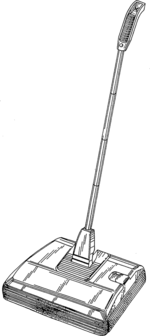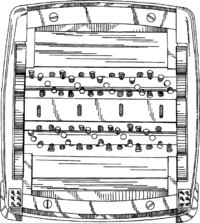Carpet sweeper

A carpet sweeper (Ewbank) is a mechanical device for the cleaning of carpets. These were popular before the introduction of the vacuum cleaner and have been largely superseded by them.
However, they continue to be used in home and commercial applications as they are lightweight and quiet, enabling users to quickly clean crumbs up from the floor without disturbing patrons, patients, babies and pets. Carpet sweepers are still available in many parts of the world.

The design was patented by Melville R. Bissell of Grand Rapids, Michigan, United States, in 1876. Bissell began selling carpet sweepers in 1883. New powered versions were designed at the beginning of the 20th century, with rechargeable batteries and an electric motor to spin the rollers and brushes.[citation needed]
Trivia
A very early appearance in film occurs in the 1914 Charlie Chaplin film Laughing Gas, where Chaplin uses it to clean the waiting-room floor of a dentist.
References